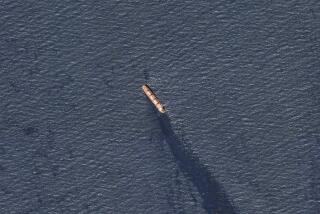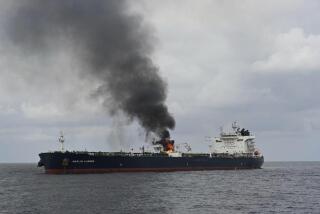Shell drilling rig runs aground in heavy Alaska seas
Days of efforts trying to guide a mobile offshore drilling rig through stormy Alaska seas hit a crisis Monday night when crew members were forced to disconnect the rig from its last remaining tow line and the vessel went aground on a small island south of Kodiak.
“The first priority was the safety of the people,” said Darci Sinclair, spokeswoman for the unified command of U.S. Coast Guard, Shell Alaska and drill ship owners who had been trying mightily to avoid just such an eventuality ever since the Kulluk rig first ran into trouble Thursday night.
The 266-foot conical drill barge first broke free of its lines last week while being towed back to port in Seattle after a summer season of drilling off the coast of Arctic Alaska. Troubles mounted when the tow vessel, the Aiviq, lost all four of its engines due to possible fuel contamination, and the drill rig was briefly adrift.
Over the weekend, the Aiviq’s engines were repaired and a second vessel was able to join it in towing the Kulluk toward safety in Kodiak. All 17 crew members on the Kulluk, which does not have its own propulsion system, were evacuated. But though the Kulluk was attached to two different towing vessels by Monday afternoon, high seas and strong winds continued to pose problems.
A line to the first tow vessel was separated at about 4:40 p.m. Then, with winds gusting to nearly 70 mph and swells of up to 40 feet, incident commanders were forced to disengage the last remaining line connecting the Kulluk to the second tow vessel, the Alert, in order to protect the Alert’s nine-member crew.
The rig was about four miles away from land at that point, incident commanders estimated.
“Once that final tow line was released, about 45 minutes later, it ran aground,” Sinclair told the Los Angeles Times.
The Kulluk struck the southeast side of Sitkalidak Island, which Sinclair said appears to be largely uninhabited.
The main concern now is potential for leakage from up to 150,000 gallons of ultra-low sulfur diesel on board the Kulluk and about 12,000 gallons of combined lube oil and hydraulic fluid also on board.
“We don’t have any reports yet of discharge. The Coast Guard has done a flyover, and once we have daylight and weather conditions permit, we’ll do a further assessment,” Sinclair said.
She said the drilling rig stores fuel for generators and other uses in the center of the vessel, encased in heavy steel.
Environmental groups which have been battling the opening of U.S. Arctic waters to offshore oil drilling quickly warned that the crippled drill rig is an example of the problems that can occur in the harsh weather conditions of the far north.
“Shell’s Arctic drilling season has been plagued with problems, missteps, and near disasters. We are fortunate that this latest incident happened close to the Coast Guard station in Kodiak. Response equipment was nearby,” the conservation group Oceana said in a statement. “If this had happened in the Arctic Ocean, Shell could have been on its own, 1,000 miles from the help it needed. The rough conditions that prevented a rescue today could be compounded by darkness and ice in the Arctic.”
Lois N. Epstein, Arctic program director for the Wilderness Society, said the incident suggests Shell’s equpment is “no match” for the Alaskan winter seas.
“Shell’s costly drilling experiment in the Arctic Ocean needs to be stopped by the federal government or by Shell itself given the unacceptably high risks it poses to both humans and the environment,” she said in a statement.
Below is Coast Guard video of the rig.
ALSO:
Bus company identified in Oregon crash that killed 9
Woman charged with murder in subway pushing death
N.Y. news site stirs outrage after publishing gun owners’ names
More to Read
Start your day right
Sign up for Essential California for news, features and recommendations from the L.A. Times and beyond in your inbox six days a week.
You may occasionally receive promotional content from the Los Angeles Times.






